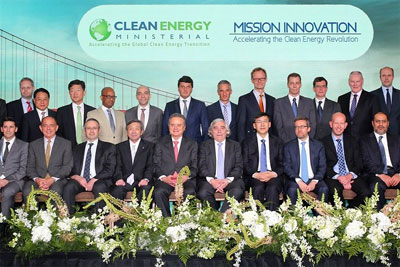Last week, Energy Ministers from 23 countries met in San Francisco to push clean energy ahead as quickly as possible.
The US launched annual Clean Energy Ministerial conferences in 2010 to bring the world’s most polluting countries together to collaborate on policies and technologies to move the world forward on clean energy. Countries attending represent 75% of the world’s greenhouse gas emissions and 90% of clean energy investment.
This year’s meeting also featured a Startups and Solutions Technology Showcase, where 100 companies and organizations from six continents demonstrated breakthrough technologies.
Mission Innovation
This year, the focus was on Mission Innovation, launched at the Paris Climate Summit. 23 countries and the EU pledged to double clean energy research – to $30 billion a year by 2021.
At the Ministerial, countries divulged how the will meet the target, and 60 companies and organizations, and 10 subnational governments committed $1.5 billion to accelerate clean energy deployment by: corporate sourcing of renewables; commercial and industrial energy efficiency, and advanced cooling technologies.
Foundations, institutional and other long term investors pledged $4 billion to scale up clean energy innovation and climate change solutions, as part of the Clean Energy Investment Initiative.
Advanced Cooling Technologies
Suddenly, air conditioners have become a major issue. As the middle class grows and the world swelters from increasingly hot temperatures, demand for air conditions is expected to soar 72%.
The Advanced Cooling Campaign challenges governments and industry to develop and scale super-efficient, affordable cooling technologies. The goal is to improve efficiency 30% by 2030.
Canada, China, India, Saudi Arabia, and US joined the Campaign, and the US is partnering with groups like the Air Conditioning, Heating, and Refrigeration Institute (AHRI) and American Society of Heating, Refrigerating, and Air Conditioning Engineers (ASHRAE) to develop HFC alternatives.
Major air conditioning manufacturers signed on. Ingersoll Rand will spend $500 million on R&D by 2020, for example, and Honeywell will spend $900 million over the next three years on research and to build manufacturing capacity.
Commercial and Industrial Energy Efficiency
The goal is for 50,000 companies to be certified under the International Organization for Standardization (ISO) 50001 by 2020. 15,000 are currently certifed.
ISO 50001 is the global energy management system standard and global implementation across commercial and industrial sectors could save over $600 billion in energy costs and corresponding reductions in greenhouse emissions – equal to taking 215 million cars off the road every year.
15 countries are participating: Canada, Chile, China, Finland, Germany, EU, Indonesia, Japan, Mexico, Republic of Korea, Russia, South Africa, Sweden, United Arab Emirates, and US. Companies have also committed to earn or maintain certification, such as Cummins, Samsung, and Schneider Electric.
Corporate Sourcing of Renewables
10% of world emissions (from electricity) can be cut if 1000 of the largest companies run on 100% renewables, according to RE100.
Germany and Denmark are leading the Campaign, and China, the UK, Sweden, EU, Mexico, and the US are participating, along with the International Renewable Energy Agency (IRENA), Renewable Energy Buyers Alliance, RE100, World Business Council for Sustainable Development (WBCSD) and World Resources Institute (WRI).
On the corporate side, Google will convene stakeholders to create policy and regulatory structures that will enable large corporate energy purchases. 65 companies are now part of RE100.
Decarbonizing the Power Sector
GO15, an association of 18 of the world’s largest power grid operators, will work with the Ministerial to address perational, technological and financial challenges to modernizing and decarbonizing grids in Mexico, India, China and elsewhere.
Energy Ministers from the US, Canada and Mexico will jointly conduct a study on creating a North American Renewable Energy Grid!
Global Lighting and Energy Access Partnership (Global LEAP) and Global Lighting Challenge: the goal is to deploy 10 billion LED bulbs around the world.
Subnational Clean Energy Ministerial
All levels of government are involved in moving to a clean energy economy. 132 local governments from 32 countries have joined Under 2 MOU, which is leading the charge. Representing 25% of the global economy, they are committed to cutting emissions 80-95% by 2050 from 1990 levels.
Leaders from the Pacific Coast Collaborative – a partnership between California, Oregon, Washington and British Columbia to tackle climate change together – announced a pact with mayors from the region’s major cities to improve buildings, transportation, and waste management on the west coast.
They signed the Pacific North America Climate Leadership Agreement, pledging to: require large buildings to benchmark and disclose energy consumption; roll out policies that encourage adoption of Zero Emission Vehicles; create a comprehensive Pacific Coast vehicle charging network; accelerate deployment of distributed and community-scale renewable energy; lower the carbon intensity of heating fuels; and advance food waste prevention and recovery initiatives.
Get all the details on Clean Energy Ministerial commitments:

